分散液液微萃取
离子液体在分散液液微萃取分离中的应用

离子液体在分散液液微萃取分离中的应用下载提示:该文档是本店铺精心编制而成的,希望大家下载后,能够帮助大家解决实际问题。
文档下载后可定制修改,请根据实际需要进行调整和使用,谢谢!本店铺为大家提供各种类型的实用资料,如教育随笔、日记赏析、句子摘抄、古诗大全、经典美文、话题作文、工作总结、词语解析、文案摘录、其他资料等等,想了解不同资料格式和写法,敬请关注!Download tips: This document is carefully compiled by this editor. I hope that after you download it, it can help you solve practical problems. The document can be customized and modified after downloading, please adjust and use it according to actual needs, thank you! In addition, this shop provides you with various types of practical materials, such as educational essays, diary appreciation, sentence excerpts, ancient poems, classic articles, topic composition, work summary, word parsing, copy excerpts, other materials and so on, want to know different data formats and writing methods, please pay attention!离子液体在分散液液微萃取分离中的应用1. 引言离子液体因其优异的化学稳定性、独特的溶解性能和可调控的物化性质,在分散液液微萃取领域展示出广阔的应用前景。
气相色谱法实验报告
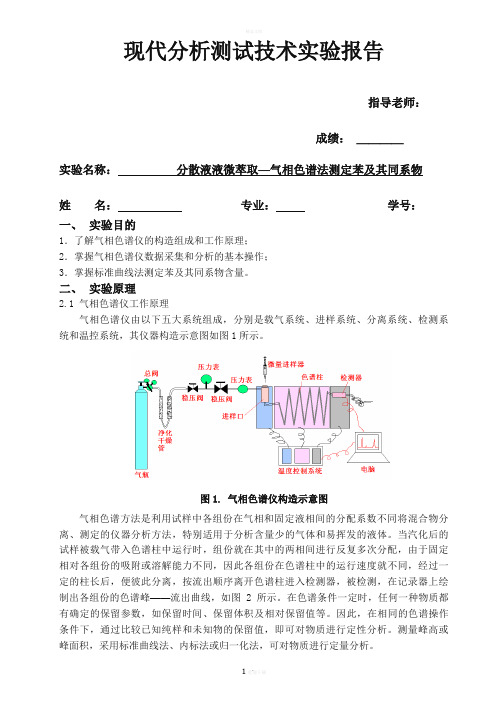
现代分析测试技术实验报告指导老师:成绩:____实验名称:分散液液微萃取—气相色谱法测定苯及其同系物姓名:专业:学号:一、实验目的1.了解气相色谱仪的构造组成和工作原理;2.掌握气相色谱仪数据采集和分析的基本操作;3.掌握标准曲线法测定苯及其同系物含量。
二、实验原理2.1 气相色谱仪工作原理气相色谱仪由以下五大系统组成,分别是载气系统、进样系统、分离系统、检测系统和温控系统,其仪器构造示意图如图1所示。
图1. 气相色谱仪构造示意图气相色谱方法是利用试样中各组份在气相和固定液相间的分配系数不同将混合物分离、测定的仪器分析方法,特别适用于分析含量少的气体和易挥发的液体。
当汽化后的试样被载气带入色谱柱中运行时,组份就在其中的两相间进行反复多次分配,由于固定相对各组份的吸附或溶解能力不同,因此各组份在色谱柱中的运行速度就不同,经过一定的柱长后,便彼此分离,按流出顺序离开色谱柱进入检测器,被检测,在记录器上绘制出各组份的色谱峰——流出曲线,如图2所示。
在色谱条件一定时,任何一种物质都有确定的保留参数,如保留时间、保留体积及相对保留值等。
因此,在相同的色谱操作条件下,通过比较已知纯样和未知物的保留值,即可对物质进行定性分析。
测量峰高或峰面积,采用标准曲线法、内标法或归一化法,可对物质进行定量分析。
图2. 色谱流出曲线2.2分散液液微萃取分散液液微萃取(Dispersive liquid-liquid microextraction,DLLME)是2006 年由Assadi提出的一种新型少溶剂的分离富集技术。
微量萃取剂在分散剂的作用下,在样品溶液中形成大量亚稳态的微滴,由于萃取剂用量少(μL 级)且与水相接触面积很大,所以可以迅速达到萃取平衡并有很高的萃取效率和富集倍数,该方法操作简便快速、环境友好。
图3. 分散液液微萃取示意图三、仪器与试剂Shimadzu 14C气相色谱仪(FID检测器,日本岛津公司);Rtx-50 毛细管色谱柱(30m×0.25 mm×0.25 μm,美国Rtstek公司);80-2型离心机(上海手术器械厂);Mili-Q超纯水系统(美国Milipore公司);5 mL具塞玻璃离心管;1.00 g/L苯、甲苯、乙苯和二甲苯(BTEX)的丙酮储备液置于0 ℃冷藏;丙酮(汕头达濠精细化学品有限公司);实验用水为超纯水;其他试剂均为分析纯。
基于低共熔溶剂的分散液液微萃取法测定茶饮料中68种农药残留
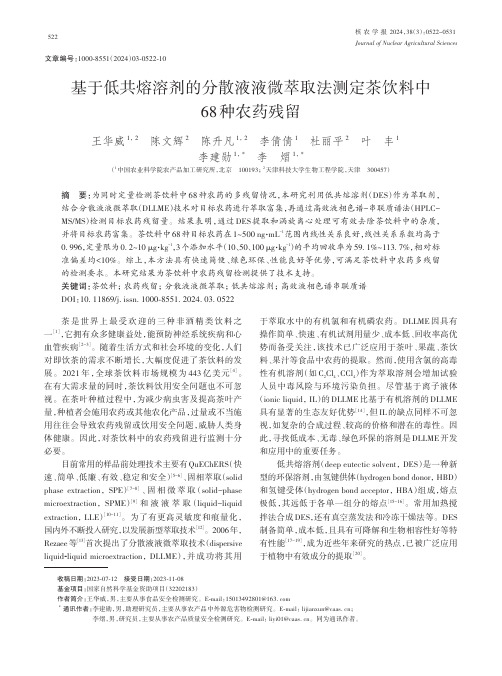
核农学报2024,38(3):0522~0531Journal of Nuclear Agricultural Sciences基于低共熔溶剂的分散液液微萃取法测定茶饮料中68种农药残留王华威1, 2陈文辉2陈升凡1, 2李倩倩1杜丽平2叶丰1李建勋1, *李熠1, *(1中国农业科学院农产品加工研究所,北京100193;2天津科技大学生物工程学院,天津300457)摘要:为同时定量检测茶饮料中68种农药的多残留情况,本研究利用低共熔溶剂(DES)作为萃取剂,结合分散液液微萃取(DLLME)技术对目标农药进行萃取富集,再通过高效液相色谱-串联质谱法(HPLC-MS/MS)检测目标农药残留量。
结果表明,通过DES提取和涡旋离心处理可有效去除茶饮料中的杂质,并将目标农药富集。
茶饮料中68种目标农药在1~500 ng·mL-1范围内线性关系良好,线性关系系数均高于0.996,定量限为0.2~10 μg·kg-1,3个添加水平(10、50、100 μg·kg-1)的平均回收率为59.1%~113.7%,相对标准偏差均<10%。
综上,本方法具有快速简便、绿色环保、性能良好等优势,可满足茶饮料中农药多残留的检测要求。
本研究结果为茶饮料中农药残留检测提供了技术支持。
关键词:茶饮料;农药残留;分散液液微萃取;低共熔溶剂;高效液相色谱串联质谱DOI:10.11869/j.issn.1000‑8551.2024.03.0522茶是世界上最受欢迎的三种非酒精类饮料之一[1],它拥有众多健康益处,能预防神经系统疾病和心血管疾病[2-3]。
随着生活方式和社会环境的变化,人们对即饮茶的需求不断增长,大幅度促进了茶饮料的发展。
2021年,全球茶饮料市场规模为443亿美元[4]。
在有大需求量的同时,茶饮料饮用安全问题也不可忽视。
在茶叶种植过程中,为减少病虫害及提高茶叶产量,种植者会施用农药或其他农化产品,过量或不当施用往往会导致农药残留或饮用安全问题,威胁人类身体健康。
分散液液微萃取PPCPs—三氯生
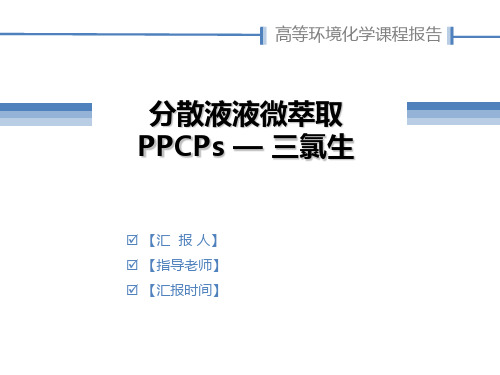
Acetone
ACN
mean ± SD mean ± SD mean ± SD
90.67 ± 1.1 55.05 ± 1.6 60.75 ± 7.2
四氢呋喃萃取效率最高!
17
分散液液微萃取的优化 萃取剂的选择
1
盐效应 4
2
分散剂的选择
3
萃取时间的影响
萃取时间的影响
萃取时间对目标物的萃取效果影响不大!
PPCPs:处方药和非处方 药,麝香、诊断剂、化妆品、 保健品、杀菌剂、遮光剂、 染发剂等。
3
PPCPs 的特点
PPCPs 概述
浓度低
污染
种类多 PPCPs 范围广
潜在 危害大
4
PPCPs 进入水体途径
PPCPs 概述
城市水循环体系中PPCPs的主要来源以及进入水体的途径
5
三氯生
三氯生,学名“二氯苯氧氯酚” 广谱抗菌剂
高等环境化学课程报告
分散液液微萃取 PPCPs — 三氯生
【汇 报 人】 【指导老师】 【汇报时间】
1
目录
1 PPCPs 概述 2 PPCPs 前处理方法 3 分散液液微萃取三氯生
2
PPCPs 定义
PPCPs 概述
药品和个人护理用品 Pharmaceutical and Personal Care Products — PPCPs
【原理】
分散液液微萃取相当于微型化的液-液萃取,是基于
三 目标元分析物在样品溶液和萃取剂之间平衡分配的过程。
溶 剂 系 统
离心
9
PPCPs 前处理方法
【原理】
三 元 溶 剂 系 统
优点
操作简单快速、有机溶剂消耗低、回收 率和富集倍数高。广泛应用于痕量分析检测。
低密度分散相液-液微萃取联用高效液相色谱法测定人血浆中的华法林

低密度分散相液-液微萃取联用高效液相色谱法测定人血浆中的华法林摘要:采用的新一代分散液-液微萃取(DLLME)联用高效液相色谱法(HPLC)提取并测定一种广泛使用的抗凝药物-华法林在人血浆中的含量。
萃取过程是基于比水轻的萃取剂和一个特殊设计的萃取装置。
我们对一些重要参数进行了调查和优化,包括萃取溶剂种类和体积、分散剂、样品溶液的pH值,样品溶液盐浓度,萃取时间等。
优化条件为(150卩L正辛醇作为萃取液,150卩L甲醇作为分散剂,样品pH值为2.3,提取时间2分钟,,不添加盐),检测限(LOD)为5ng • mL-1和提取回收率91.0%; 校准曲线的线性范围为15 - 3000 mL-1,相关系数的(R2)为0.998。
基于五次提取及测定的重复性和再现性分别为 2.8%和6.5%。
该方法已成功应用在服用华法林患者血浆药物浓度的测定,,并具有灵敏、高效和方便的特点。
关键词:低密度溶剂;分散相液-液微萃取;法华林;HPLC ;样品前处理;血浆样品分析1.简介华法林是一种广泛使用于口服抗凝药物预防和治疗静脉、动脉血栓栓塞疾病的香豆素衍生物。
它能引起致命性出血,可作为杀鼠剂应用。
华法林通过减小维生素K的依赖性凝血因子的合成发挥抗凝血作用。
华法林的治疗窗很窄,超过了治疗窗会导致不必要的出血。
华法林的血浆浓度不但可以区分是否具有真正的抗凝血性能并且为临床决策、有效治疗严重中毒提供更加完善的参考价值。
因此,各种方法如高效液相色谱法(HPLC)和紫外检测器的液相色谱-串联质谱法(LC-MS / MS )胶束电动色谱-电喷雾电离质谱(ESI-MS法)和毛细管区带电泳(CZE)都已用于测定华法林在生物样品的浓度。
由于低浓度的华法林基质较为复杂,不能直接使用以上方法。
这些方法一般使用液液萃取(LLE)或固相萃取(SPE)技术进行样品制备。
液液萃取有高重复性和高采样能力的优点,但它过程繁琐、耗时,易产生乳剂,需要大量有毒而昂贵的有机溶剂对其进行提取。
分散液液微萃取-石墨炉原子吸收光谱法测定环境水样中的痕量镉
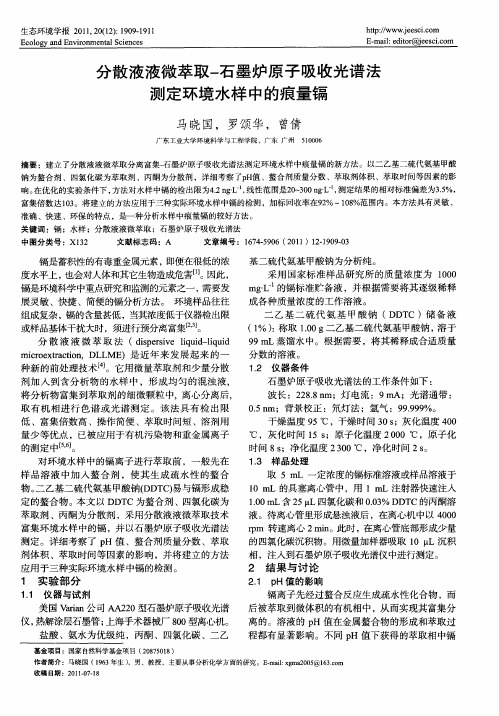
A针 l对萃取镉的影 响。若将测定结果 的相对误差在 + 0%以内视 为不 干扰 ,则 上述 离子 与 C 的最 高 1 允 许浓 度 比依次 为 :Na 3 0 ( 0)、 0 ( 0 3 0)、 0
镉是环境科学中重点研究和监测的元素之一, 需要发 展灵敏 、快捷、简便的镉分析方法。 环境样品往往 组成复杂 , 镉的含量甚低,当其浓度低于仪器检出限 或样 品基体干扰 大时 ,须进行 预分 离富集LJ z。 分 散 液 液 微 萃 取 法 ( i e ie l u -i i ds rv i i l u ps qd qd miret cin L ME coxr t ,D L )是 近 年来 发 展起 来 的一 a o 种新的前处理技术【 4 ] 。它用微量萃取剂和少量分散
26 共存 离 子 的影 响 .
0 O . 2 O 0 .3 0 O . 4 O. 5 0
水样 中某些 能 与 D C 反应 生 成 疏水 性螯 合 DT
W( DDT ) C/ % 图 2 D C质 量分 数对 镉萃 取 的影 响 DT
Fg2 E e t f i . f c DDTC ma sfa t n o ee ta t no c d u o s r ci n t x c i f a mi m o h r o
中图分 类号 :X12 3 文献标 志码 :A 文章 编号 :1 7 -9 6( 0 )1-9 90 6 450 2 1 1 2 10 —3
镉 是蓄积 I 生的有毒重金属元 素 ,即便在很低 的浓 度水平上, 也会对人体和其它生物造成危害L 因此 , 1 J 。
基二 硫代 氨基 甲酸 钠为 分析 纯 。 采用 国家 标 准样 品 研究 所 的质 量浓 度 为 10 00 m・ g 。的镉标准贮备液,并根据需要将其逐级稀释 L 成各 种质 量浓 度 的工作 溶液 。 二 乙 基 二 硫 代 氨 基 甲酸 钠 ( DT D C)储 备 液 ( % ) 称取 1 0g二 乙基二 硫 代氨基 甲酸钠 , 于 1 : . 0 溶
分散液液微萃取
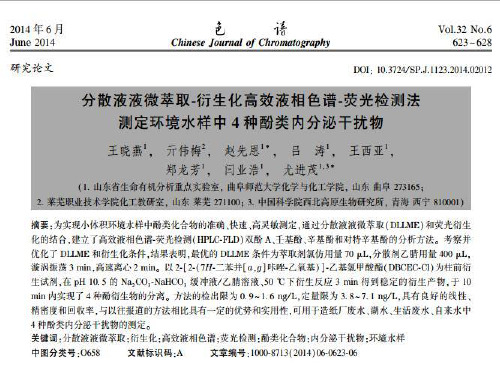
本研究的目标是通过DLLME和荧光衍生化 的有效结合,实现室温下小体积环境水样中4 种酚类污染物的快速、简便、高效萃取,为 环境分析工作提供有效途径。由于在酸性 条件下酚类化合物才完全以分子形式存在, 有利于有机溶剂萃取,因此本研究用稀盐酸 将水样pH调至4.0再进行萃取。以HPLCFLD测定的峰面积为参照,用同一份加标水 样对比优化DLLME参数。
利用DLLME技术与高灵敏荧光衍生化相结 合的策略,建立了4种酚类污染物的HPLCFLD测定方法。该方法具有操作简便、高灵 敏、快速、准确、环境友好等特点,且具有 一定的实用性。检测结果显示,工业废水、 生活废水中含有一定量的酚类内分泌干扰 物,需进行水处理和监控,以减少对生态系统 和饮用水的污染。
水中酚类化合物的提取方法常用液液萃取法 (LLE)[ 4 ]和固相萃取法(SPE)[ 5,6 ],但存在萃取率 低、有机溶剂消耗大、操作繁琐等缺点。自2006 年Assadi等[ 7 ]首次报道分散液液微萃取 (dispersive liquid-liquid microextraction,DLLME) 以来,因其所需萃取溶剂量少、萃取速度快、萃取 效率和富集倍数高、操作简便和环境友好等优点, 已逐渐成为一种极具潜力的分离富集技术 [ 8 ],DLLME已被应用于多种酚类化合物的萃取 [ 9,10 ]。
采用上述最优化条件进行一次DLLME后,完 全吸取下层有机相,再对该水样进行一次 DLLME提取并衍生化后进行HPLC-FLD测 定,未见4种酚被检出。该结果表明所建立的 DLLME条件对酚类污染物的萃取率高。
传统的有机溶剂液液萃取法[ 4 ],操作繁琐、 费时、费力,应用该方法进行提取,3次测定 的加标回收率均低于70% 。DLLME法与其 相比,具有有机溶剂用量少、快速、简便、 萃取效率高等优点。
分散液液微萃取-分光光度法测定水中结晶紫

分散液液微萃取-分光光度法测定水中结晶紫吕瑞;罗帆;龙宣羽;景艳琼【摘要】建立了分散液液微萃取-分光光度法测定环境水样中的结晶紫的分析方法,考察了萃取剂的种类、体积,分散剂的种类、体积,萃取时间,离心时间等因素对萃取效率的影响,并得到了最优萃取条件.在该条件下对环境水样中的结晶紫进行了分离测定,结果表明方法的检出限为6.78 μg/L,富集倍数是20.5,平均回收率为99.47%,RSD为2.02%.该方法可运用于测定环境水样中的痕量结晶紫.【期刊名称】《广州化工》【年(卷),期】2017(045)015【总页数】3页(P135-137)【关键词】分散液液微萃取;环境水样;结晶紫【作者】吕瑞;罗帆;龙宣羽;景艳琼【作者单位】绵阳师范学院化学与化学工程学院,四川绵阳 621000;绵阳师范学院化学与化学工程学院,四川绵阳 621000;绵阳师范学院化学与化学工程学院,四川绵阳 621000;绵阳师范学院化学与化学工程学院,四川绵阳 621000【正文语种】中文【中图分类】O657.32结晶紫,又名甲紫、龙胆紫,俗名紫药水,属于人工合成的三苯甲烷类碱性工业染料,由于其价格低廉,且对鱼类的水霉病、寄生虫病等有较好的疗效,曾被广泛用作水产养殖中的杀菌消毒剂[1]。
但已有研究表明,它是一种致癌物质,可能导致啮齿类动物出现某种肉瘤和腺瘤,还可能出现肝癌,此外,结晶紫还可能导致突变和染色体断裂[2-3]。
目前,包括中国在内的许多国家都将结晶紫列为水产养殖中的禁用药物。
因此,检测环境水中的结晶紫对于水产养殖的环境监控有着重要意义。
由于水中结晶紫含量低,须借助富集技术进行分离检测。
液液萃取法作为一种有效的分离富集技术,已广泛用于工业分析、中药提取以及环境监测等方面,但常规的液液萃取技术中有机溶剂用量较大,易对环境造成污染甚至引发安全事故,基于此,分散液液微萃取法应运而生[4]。
分散液液微萃取是在液液萃取法的基础上发展起来的一种新型的样品前处理技术,它兼备萃取和浓缩两个环节,由于其萃取剂用量小,操作简单、萃取效率高,环境污染小,目前已广泛用于金属离子富集[5]、食品分析[6]、环境污染物测定[7]以及农药残留检测[8]等方面。
分散液液微萃取技术及在食品和环境分析中的应用概述
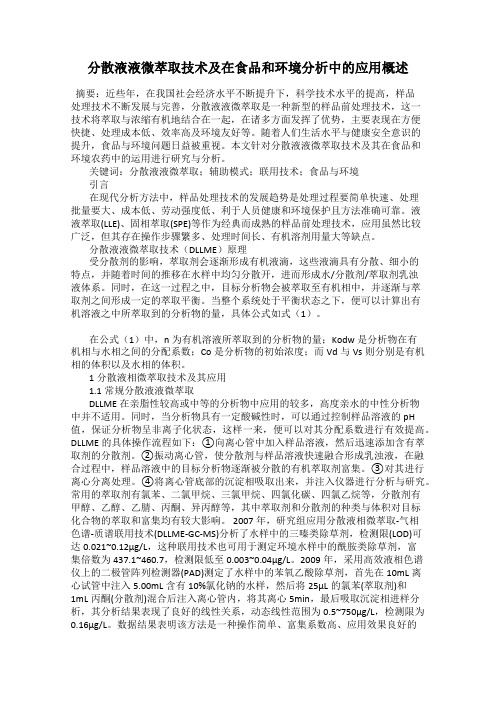
分散液液微萃取技术及在食品和环境分析中的应用概述摘要:近些年,在我国社会经济水平不断提升下,科学技术水平的提高,样品处理技术不断发展与完善,分散液液微萃取是一种新型的样品前处理技术,这一技术将萃取与浓缩有机地结合在一起,在诸多方面发挥了优势,主要表现在方便快捷、处理成本低、效率高及环境友好等。
随着人们生活水平与健康安全意识的提升,食品与环境问题日益被重视。
本文针对分散液液微萃取技术及其在食品和环境农药中的运用进行研究与分析。
关键词:分散液液微萃取;辅助模式;联用技术;食品与环境引言在现代分析方法中,样品处理技术的发展趋势是处理过程要简单快速、处理批量要大、成本低、劳动强度低、利于人员健康和环境保护且方法准确可靠。
液液萃取(LLE)、固相萃取(SPE)等作为经典而成熟的样品前处理技术,应用虽然比较广泛,但其存在操作步骤繁多、处理时间长、有机溶剂用量大等缺点。
分散液液微萃取技术(DLLME)原理受分散剂的影响,萃取剂会逐渐形成有机液滴,这些液滴具有分散、细小的特点,并随着时间的推移在水样中均匀分散开,进而形成水/分散剂/萃取剂乳浊液体系。
同时,在这一过程之中,目标分析物会被萃取至有机相中,并逐渐与萃取剂之间形成一定的萃取平衡。
当整个系统处于平衡状态之下,便可以计算出有机溶液之中所萃取到的分析物的量,具体公式如式(1)。
在公式(1)中,n为有机溶液所萃取到的分析物的量;Kodw是分析物在有机相与水相之间的分配系数;Co是分析物的初始浓度;而Vd与Vs则分别是有机相的体积以及水相的体积。
1分散液相微萃取技术及其应用1.1常规分散液液微萃取DLLME在亲脂性较高或中等的分析物中应用的较多,高度亲水的中性分析物中并不适用。
同时,当分析物具有一定酸碱性时,可以通过控制样品溶液的pH 值,保证分析物呈非离子化状态,这样一来,便可以对其分配系数进行有效提高。
DLLME的具体操作流程如下:①向离心管中加入样品溶液,然后迅速添加含有萃取剂的分散剂。
一种新的液液萃取模式_分散液液微萃取
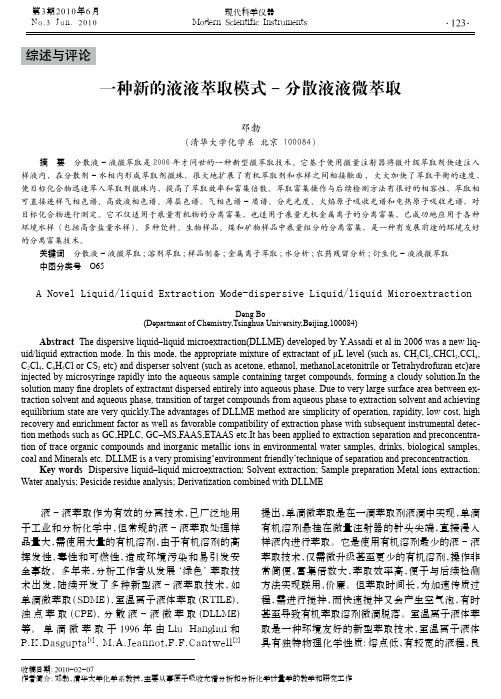
现代科学仪器Modern Scientific Instruments第3期2010年6月N o.3 J u n. 2010123一种新的液液萃取模式-分散液液微萃取邓勃(清华大学化学系 北京 100084)摘 要 分散液-液微萃取是2006年才问世的一种新型微萃取技术。
它基于使用微量注射器将微升级萃取剂快速注入样液内,在分散剂-水相内形成萃取剂微珠,很大地扩展了有机萃取剂和水样之间相接触面, 大大加快了萃取平衡的速度,使目标化合物迅速萃入萃取剂微珠内,提高了萃取效率和富集倍数。
萃取富集操作与后续检测方法有很好的相容性,萃取相可直接进样气相色谱、高效液相色谱、薄层色谱、气相色谱-质谱、分光光度、火焰原子吸收光谱和电热原子吸收光谱,对目标化合物进行测定。
它不仅适用于痕量有机物的分离富集,也适用于痕量无机金属离子的分离富集,已成功地应用于各种坏境水样(包括高含盐量水样)、多种饮料、生物样品、煤和矿物样品中痕量组分的分离富集,是一种有发展前途的环境友好的分离富集技术。
关键词 分散液-液微萃取;溶剂萃取;样品制备;金属离子萃取;水分析;农药残留分析;衍生化-液液微萃取中图分类号 O65A Novel Liquid/liquid Extraction Mode-dispersive Liquid/liquid Microextraction Deng Bo(Department of Chemistry,Tsinghua University,Beijing,100084)Abstract The dispersive liquid–liquid microextraction(DLLME) developed by Y .Assadi et al in 2006 was a new liq-uid/liquid extraction mode. In this mode, the appropriate mixture of extractant of μL level (such as, CH 2Cl 2,CHCl 3,CCl 4,C 2Cl 4, C 6H 5Cl or CS 2 etc) and disperser solvent (such as acetone, ethanol, methanol,acetonitrile or Tetrahydrofuran etc)are injected by microsyringe rapidly into the aqueous sample containing target compounds, forming a cloudy solution.In the solution many fi ne droplets of extractant dispersed entirely into aqueous phase. Due to very large surface area between ex-traction solvent and aqueous phase, transition of target compounds from aqueous phase to extraction solvent and achieving equilibrium state are very quickly.The advantages of DLLME method are simplicity of operation, rapidity, low cost, high recovery and enrichment factor as well as favorable compatibility of extraction phase with subsequent instrumental detec-tion methods such as GC,HPLC, GC–MS,FAAS,ETAAS etc.It has been applied to extraction separation and preconcentra-tion of trace organic compounds and inorganic metallic ions in environmental water samples, drinks, biological samples, coal and Minerals etc. DLLME is a very promising‘environment friendly’technique of separation and preconcentraction.Key words Dispersive liquid–liquid microextraction; Solvent extraction; Sample preparation Metal ions extraction; Water analysis; Pesicide residue analysis; Derivatization combined with DLLME收稿日期:2010-02-07作者简介:邓勃,清华大学化学系教授,主要从事原子吸收光谱分析和分析化学计量学的教学和研究工作液-液萃取作为有效的分离技术,已广泛地用于工业和分析化学中,但常规的液-液萃取处理样品量大,需使用大量的有机溶剂,由于有机溶剂的高挥发性、毒性和可燃性,造成环境污染和易引发安全事故。
分散液液微萃取用于苦瓜HPLC指纹图谱的研究
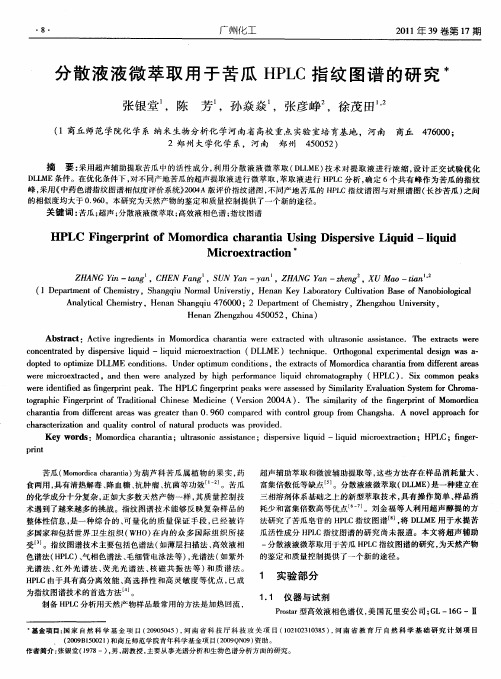
\
、~
1 2 苦瓜样 品 的制备 .
将 新 鲜 苦 瓜 果 肉洗 净 后 切 碎 ,0℃ 烘 干 , 碎后 过 6 目筛 , 6 研 0 得 到苦 瓜 粉 , 燥 保 存 。准 确 称 取 1g苦 瓜 粉 , 于 5 L容 量 干 置 0m 瓶 中 , 入 3 L 甲醇 :乙 醇 = 0:1 V V) 溶 液 , 6 加 0m 9 0( / 的 在 0℃ 下 超 声 6 i, 500rm 的转 速 离心 3 n 用 04 , 微 孑 0m n 以 0 p 0mi, .5p m L 滤 膜 过 滤 , 液 加入 等体 积 甲 醇 , 到 苦 瓜 提 取 液 样 品 。 滤 得
M i r e t a to c o x r c in
ZHANG n —t n Yi a g‘ C HEN n Fa g ,SUN a —y Yh an‘ ZHANG a Y n—z e g ,XU o—t hn Ma i ・ an。
, ,
( e at e t fC e sy S a g i N r a U iesy e a e a oao ut ai aeo a oil i l 1D pr n h mir , h n q om l nvrt ,H nnK yL b rt C lvt nB s f n bo g a m o t u i y r i o N oc
取工作液。在 15 m . L尖底 离心 管 中, 加入 80 I 0 L 萃取 工 作 L微 液 ,5I C 萃取剂) 20I 2 L C 1( L 和 0 L乙腈( L 分散剂) 振荡均匀 , , 形成 7 / E 乙腈 的乳浊液体系。以 350rm的转速离心 2 i, k El / 0 p 0mn 用
基金项 目: 国家 自然 科 学 基金 项 目 ( 0 00 5) 河 南 省 科 技 厅科 技攻 关 项 目 ( 0 12 13 5) 河 南 省 教 育 厅 自然 科 学 基 础 研 究 计 划 项 目 2 95 4 , 12 0 30 8 ,
分散液液微萃取-气相色谱法测定环境水样中间甲苯酚
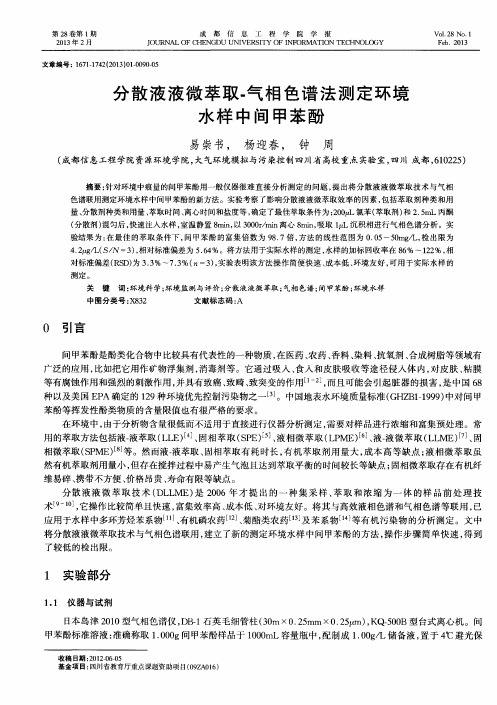
第1 期
易崇书等 : 分散 液液微 萃取一 气相 色谱 法 测定环 境 水样 中间 甲苯 酚
9 1
存, 使用 时用 水逐 级稀 释 。其余试 剂 ( 氯苯 、 乙醇 、 丙 酮等 ) 均 为分 析纯 , 实验 用 水为超 纯 水 。
1 . 2 色 谱检 测条 件
载气为高纯氮气( 纯度为 9 9 . 9 9 9 %) , 流速 3 0 mL / m i n ; 燃气为高纯氢气( 纯度为 9 9 . 9 9 9 %) , 流速 3 0 m L / m i n ;
维 易碎 、 携带 不方 便 、 价 格 昂贵 、 寿命有 限等 缺点 。
分散 液液微 萃取 技术 ( D L u ) 是2 0 0 6年才 提 出的一种 集采 样 、 萃 取 和浓缩 为一体 的样 品前处 理技 术c 9 , 它 操作 比较简 单且快 速 , 富集 效率 高 、 成本 低 、 对 环境 友好 。将 其与 高效液 相 色谱和 气相 色谱 等 联用 , 已 应 用 于水样 中多环芳 烃苯 系物 【 1 1 J 、 有机 磷农 药【 1 2 J 、 菊酯 类农 药 [ 1 3 ] 及 苯 系物 [ H] 等 有 机污 染 物 的分 析 测定 。文 中
摘 要: 针对环境中痕量 的间甲苯酚用一般仪器很难 直接 分析测定 的问题 , 提 出将 分散液 液微萃取 技术与气 相 色谱联用测定环境水样 中间甲苯酚 的新方法 。实验考察 了影响分散液液微萃取效率 的因素 , 包括 萃取剂种类 和用 量、 分散剂种类和用量 、 萃取时 间 、 离心时间和盐度等 , 确定 了最佳萃取条件为 : 2 0 0 t  ̄ L氯苯 ( 萃取剂 ) 和2 . 5 mL丙酮
广泛 的应 用 , 比如把 它用 作矿 物浮集 剂 , 消毒剂 等 。它通 过 吸入 、 食入 和 皮肤 吸 收等 途 径侵 人 体 内, 对皮肤 、 粘 膜
分散液-液微萃取—火焰原子吸收光谱法测定水样中的痕量铅
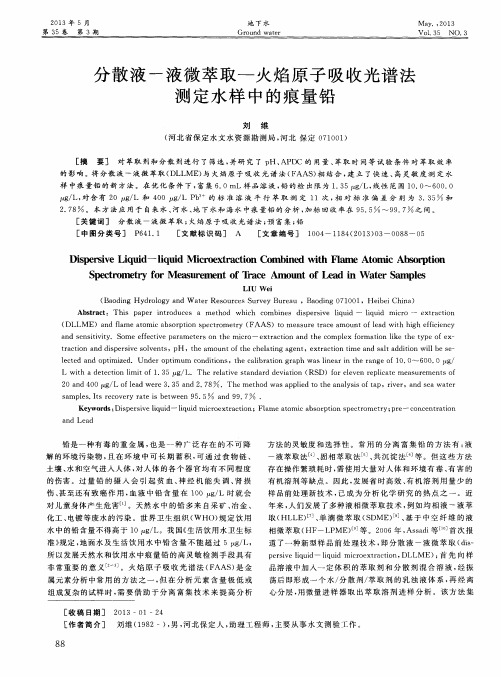
( Ba o d i n g Hy d r o l o g y a n d W a t e r Re s o u r c e s S u r v e y Bu r e a u ,Ba o d i n g 0 71 0 0 1。H e i b e i Ch i na ) Ab s t r a c t : Th i s p a p e r i n t r o d u c e s a me t h o d wh i c h c o mb i ne s d i s p e r s i v e l i q u i d~ l i q u i d m i c r o~ e x t r a c t i o n ( DI LM E)a n d f l a me a t o mi c a b s o r p t i o n s p e c t r o me t r y( FAA S)t O me a s u r e t r a c e a mo u n t o f l e a d wi t h h i g h e f f i c i e n c y a n d s e n s i t i v i t y .S o me e f f e c t i v e p a r a me t e r s o n t h e mi c r o — e x t r a c t i o n a n d t h e c o mp l e x f o r ma t i o n l i k e t h e t y p e o f e x — t r a c t i o n a n d d i s p e r s i v e s o l v e n t s ,pH ,t h e a mo u n t o f t h e c h e l a t i n g a g e n t ,e x t r a c t i o n t i me a n d s a l t a d d i t i o n wi l l b e s e —
溶剂去乳化-悬浮固化分散液液微萃取-气相色谱-质谱联用测定水中的有机氯农药
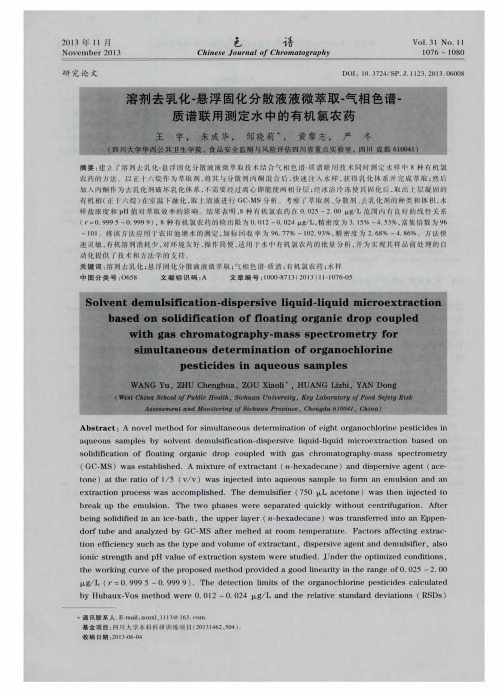
wa s ap pl i e d t o t h e de t e r mi na t i o n o f f a r ml a nd w a t e r, t he a v e r a g e s pi ke d r e c o ve r i e s w e r e 9 6. 7 7 % 一1 02 . 9 3 % wi t h t he r e l a t i v e s t a nd a r d d e vi a t i o ns 0f 2. 6 8 % 一4. 8 6 % . The pr o pos ed me t h.
c a t i o n o f l f o a t i n g o r g a n i c d r o p;g a s c h r o ma t o g r a p h y — ma s s s p e c t r o me t r y( GC — MS );o r g a n o c h l o —
OUS s a m pl e s . M e a n w hi l e, i t pr o vi d e s t ec hni c a l a nd me t hod ol o g i c a l s u ppo r t f or a c hi e v i ng t he
l i di f i c a t i o n loa f t i ng o r g a ni c d r o p l i q ui d pha s e mi —
分散液液微萃取

分散液液微萃取分散液液微萃取是一种基于高效液相色谱技术的样品前处理方法,它可以有效地提高样品的纯度和灵敏度,同时减少了样品处理的时间和成本。
本文将介绍分散液液微萃取的原理、优点和应用。
一、原理分散液液微萃取的原理基于液液萃取的基础上,它采用微量的有机溶剂形成的微小液滴,与样品中的目标分子相互作用,实现目标分子的富集和分离。
相对于传统的液液萃取方法,分散液液微萃取具有以下优点:1. 可以使用微量的有机溶剂,减少了有机溶剂的消耗和环境污染。
2. 分散液液微萃取的液滴大小可以控制,从而可以实现高效的富集和分离。
3. 分散液液微萃取的速度快,可以在短时间内完成富集和分离过程。
4. 分散液液微萃取的富集效率高,可以实现对少量样品的富集和分离。
二、优点分散液液微萃取具有以下优点:1. 高效性:分散液液微萃取可以实现对少量目标分子的高效富集和分离,从而提高了样品的灵敏度和纯度。
2. 选择性:分散液液微萃取可以通过选择不同的有机溶剂和条件,实现对不同目标分子的选择性富集和分离。
3. 简便性:分散液液微萃取可以在短时间内完成富集和分离过程,从而节省了样品处理的时间和成本。
4. 环保性:分散液液微萃取可以使用微量的有机溶剂,减少了有机溶剂的消耗和环境污染。
5. 适用性:分散液液微萃取适用于多种样品的前处理,包括环境样品、食品样品、生物样品等。
三、应用分散液液微萃取在环境、食品和生物领域中有广泛的应用。
1. 环境领域:分散液液微萃取可以用于环境样品中有机污染物的富集和分离,如水中的有机物、土壤中的农药等。
2. 食品领域:分散液液微萃取可以用于食品中的残留物的富集和分离,如农药、重金属、食品添加剂等。
3. 生物领域:分散液液微萃取可以用于生物样品的前处理,如血液、尿液、唾液中的生物分子的富集和分离。
四、总结分散液液微萃取是一种高效、简便、环保的样品前处理方法,它可以实现对少量目标分子的高效富集和分离。
在环境、食品和生物领域中有广泛的应用。
分散液相微萃取
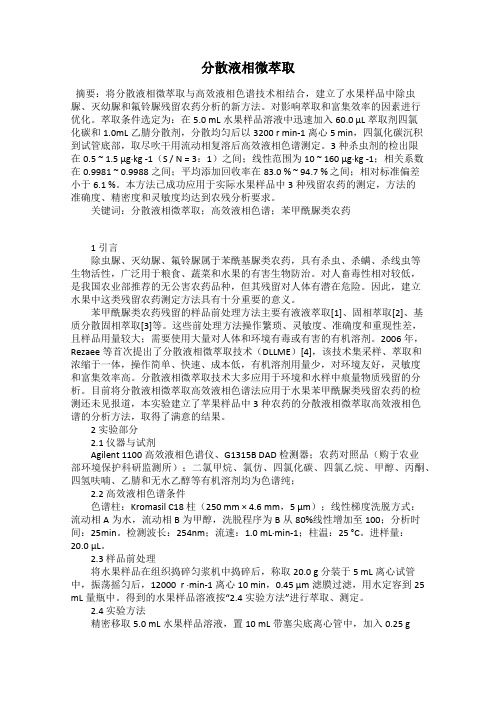
分散液相微萃取摘要:将分散液相微萃取与高效液相色谱技术相结合,建立了水果样品中除虫脲、灭幼脲和氟铃脲残留农药分析的新方法。
对影响萃取和富集效率的因素进行优化。
萃取条件选定为:在5.0 mL水果样品溶液中迅速加入60.0 μL萃取剂四氯化碳和1.0mL乙腈分散剂,分散均匀后以3200 r min-1 离心5 min,四氯化碳沉积到试管底部,取尽吹干用流动相复溶后高效液相色谱测定。
3种杀虫剂的检出限在0.5 ~ 1.5 μg·kg -1(S / N = 3:1)之间;线性范围为10 ~ 160 μg·kg -1;相关系数在0.9981 ~ 0.9988之间;平均添加回收率在83.0 % ~ 94.7 % 之间;相对标准偏差小于6.1 %。
本方法已成功应用于实际水果样品中3种残留农药的测定,方法的准确度、精密度和灵敏度均达到农残分析要求。
关键词:分散液相微萃取;高效液相色谱;苯甲酰脲类农药1 引言除虫脲、灭幼脲、氟铃脲属于苯酰基脲类农药,具有杀虫、杀螨、杀线虫等生物活性,广泛用于粮食、蔬菜和水果的有害生物防治。
对人畜毒性相对较低,是我国农业部推荐的无公害农药品种,但其残留对人体有潜在危险。
因此,建立水果中这类残留农药测定方法具有十分重要的意义。
苯甲酰脲类农药残留的样品前处理方法主要有液液萃取[1]、固相萃取[2]、基质分散固相萃取[3]等。
这些前处理方法操作繁琐、灵敏度、准确度和重现性差,且样品用量较大;需要使用大量对人体和环境有毒或有害的有机溶剂。
2006年,Rezaee等首次提出了分散液相微萃取技术(DLLME)[4],该技术集采样、萃取和浓缩于一体,操作简单、快速、成本低,有机溶剂用量少,对环境友好,灵敏度和富集效率高。
分散液相微萃取技术大多应用于环境和水样中痕量物质残留的分析。
目前将分散液相微萃取高效液相色谱法应用于水果苯甲酰脲类残留农药的检测还未见报道,本实验建立了苹果样品中3种农药的分散液相微萃取高效液相色谱的分析方法,取得了满意的结果。
联苯-联苯醚混合萃取剂分散液液微萃取测定饮用水中挥发性卤代烃
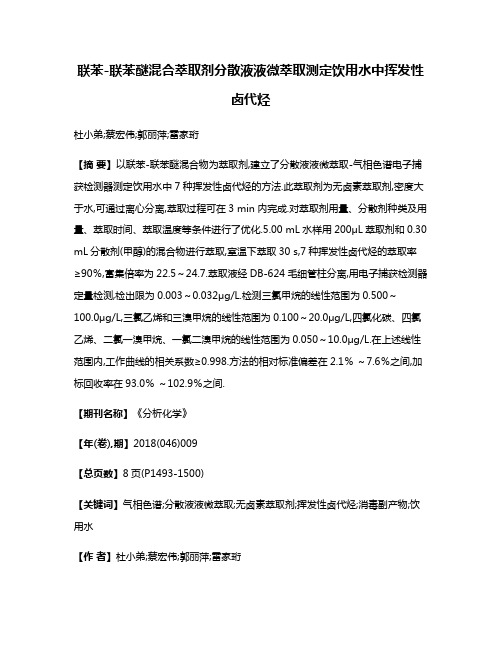
联苯-联苯醚混合萃取剂分散液液微萃取测定饮用水中挥发性卤代烃杜小弟;蔡宏伟;郭丽萍;雷家珩【摘要】以联苯-联苯醚混合物为萃取剂,建立了分散液液微萃取-气相色谱电子捕获检测器测定饮用水中7种挥发性卤代烃的方法.此萃取剂为无卤素萃取剂,密度大于水,可通过离心分离,萃取过程可在3 min内完成.对萃取剂用量、分散剂种类及用量、萃取时间、萃取温度等条件进行了优化.5.00 mL水样用200μL萃取剂和0.30 mL分散剂(甲醇)的混合物进行萃取,室温下萃取30 s,7种挥发性卤代烃的萃取率≥90%,富集倍率为22.5~24.7.萃取液经DB-624毛细管柱分离,用电子捕获检测器定量检测,检出限为0.003~0.032μg/L.检测三氯甲烷的线性范围为0.500~100.0μg/L,三氯乙烯和三溴甲烷的线性范围为0.100~20.0μg/L,四氯化碳、四氯乙烯、二氯一溴甲烷、一氯二溴甲烷的线性范围为0.050~10.0μg/L.在上述线性范围内,工作曲线的相关系数≥0.998.方法的相对标准偏差在2.1%~7.6%之间,加标回收率在93.0%~102.9%之间.【期刊名称】《分析化学》【年(卷),期】2018(046)009【总页数】8页(P1493-1500)【关键词】气相色谱;分散液液微萃取;无卤素萃取剂;挥发性卤代烃;消毒副产物;饮用水【作者】杜小弟;蔡宏伟;郭丽萍;雷家珩【作者单位】武汉理工大学化学化工与生命科学学院化学系,武汉430070;武汉理工大学化学化工与生命科学学院化学系,武汉430070;武汉理工大学化学化工与生命科学学院化学系,武汉430070;武汉理工大学化学化工与生命科学学院化学系,武汉430070【正文语种】中文1 引言挥发性卤代烃是重要的环境污染物。
特别是采用氯气消毒工艺的饮用水中,三卤甲烷等众多挥发性卤代烃作为消毒副产物而广泛存在[1,2]。
国内外对饮用水中多种卤代烃都有严格的限量[3,4],我国生活饮用水卫生标准规定的三氯甲烷和四氯化碳含量限值分别为60和2 μg/L,比世界卫生组织(WHO)的推荐值更加严格。
- 1、下载文档前请自行甄别文档内容的完整性,平台不提供额外的编辑、内容补充、找答案等附加服务。
- 2、"仅部分预览"的文档,不可在线预览部分如存在完整性等问题,可反馈申请退款(可完整预览的文档不适用该条件!)。
- 3、如文档侵犯您的权益,请联系客服反馈,我们会尽快为您处理(人工客服工作时间:9:00-18:30)。
Dispersive by microvolume Saadat Rastegarzadeh Department of Chemistry,detection.Analysis of fungicide thiram in environmental and agricultural samples was performed.a r t i c l e i n f o Article history:Received 11February 2013Received in revised form 7May 2013Accepted 8May 2013Available online 23May 2013Keywords:ThiramDispersive liquid–liquid microextraction Microvolume spectrophotometrya b s t r a c tA novel and simple method for the sensitive determination of trace amounts of fungicide thiram is devel-oped by combination of dispersive liquid–liquid microextraction (DLLME)and microvolume UV–vis spectrophotometry.The method is based on the conversion of thiram to a yellow product in the presence of ethanolic potassium hydroxide and copper sulfate,and its extraction into CCL 4using DLLME technique.In this method the ethanol existing in ethanolic KOH plays as disperser solvent and a cloudy solution is formed by injection of only CCl 4as extractant solvent into sample solution.Under the optimum condi-tions,the calibration graph was linear over the range of 25–1000ng mL À1of thiram with limit of detec-tion of 11.5ng mL À1.The relative standard deviation (RSD)for 100and 500ng mL À1of thiram was 2.7and 1.1%(n =8),respectively.The proposed method was successfully applied to determination of thiram in water and plant seed samples.Ó2013Elsevier B.V.All rights reserved.IntroductionDithiocarbamates (DTCs)are a group of organosulfur com-pounds that have been extensively used as pesticides in agriculture and horticulture over several decades [1,2].DTCs can be catego-rized into three subclasses depending upon their carbon skeleton including dimethyldithiocarbamates (DMDs),ethylenebis (dithio-carbamates)(EBDs),and propylenebis (dithiocarbamates)(PBDs).Among these,thiram (tetramethyl thiuram disulfide)(Fig.1)is a well-known dithiocarbamate fungicide that has been in commer-cial use since 1925[3].Thiram is widely used to prevent crop dam-age in the field and to protect harvested crops from deterioration in storage or transport and is also used as a seed protectant to control anumber of fungal diseases [4].Therefore,it extensively applied as a foliar treatment on fruits,vegetables,ornamentals and turf crops from a variety of fungal diseases.In addition,it is used as an animal repellent to protect fruittrees and ornamentals from damage by rabbits,rodents,and deer.Thiram is also used in rubber industry,in the treatment of human scabies,as a sunscreen,and as a bacte-ricide in soap [5–7].Although the usability of this dithiocarbamate compound is unassailable,its increasing application results in1386-1425/$-see front matter Ó2013Elsevier B.V.All rights reserved./10.1016/j.saa.2013.05.020Corresponding author.Tel./fax:+986113331042.E-mail addresses:rastegarz@ ,rastegarz@scu.ac.ir (S.Rastegarzadeh).being released into the environment leading to contamination of water,soil,and food.These contaminants adversely affect the envi-ronment and have serious hazardous effect in the living organisms.The reported studies on rats showed that the exposure to thiram has harmful effects on hepatic system and skin such as skin lesions (e.g.hand eczema or dermatitis),hepatic dysfunctions,neurotox-icity and citotoxicity [8].The residual amounts of thiram in human diet in combination with nitrite represent the potential precursor for the formation of carcinogenic nitrosamine.Furthermore,it has been mentioned that in body,carbon disulfide is formed from the breakdown of thiram and contributes to the toxicity of thiram to the liver [9].According to the US EPA (Environmental Protection Agency),thiram is expected to be sufficiently mobile and persistent in some cases to reach surface waters in concentrations high enough to impact aquatic life [10].To evaluate the risks of its intensive use,the determination of thiram in environmental matrixes is necessary to assay the thiram residues.Various analytical methods have been reported for the determi-nation of thiram in different crop matrices and environmental samples,including mass spectrometry [3,5],high-performance liquid chromatography [10–12],spectrophotometry [7,13,14],gas chromatography [15],polarography and voltammetry [16–18]chemiluminescence analysis [6,8,19]and surface-enhanced Raman scattering spectroscopy [1].The sample preconcentration step which has attracted much attention in analytical procedure includes the extraction of inter-ested components from a sample matrix.The most popular pre-treatment methods are liquid–liquid extraction (LLE)and solid phase extraction (SPE).Nevertheless,these conventional extraction methods are laborious,time-consuming and require large volumes of samples and toxic organic solvents.In the past years,several techniques particularly microextraction have been developed for sample preconcentration,due to the many advantages which makes it more attractive with respect to classic extraction approaches.Dispersive liquid–liquid microextraction (DLLME)as a considerable microextraction technique was emerged by Assadi et al.in 2006[20],which was based on a ternary solvent system like homogeneous LLE and cloud point extraction.In this method,an appropriate mixture of extraction and dispersive solvents is in-jected rapidly into an aqueous sample,resulting in the formation of a cloudy solution.The contact area between the extracting solvent and the sample solution is extremely large;thus,the extraction equilibrium is obtained rapidly.The advantages of DLLME are the usage of a small volume of organic solvents,simplicity of the oper-ation,rapidity,low cost,high recovery,high enrichment factor and environmentally friendly nature.Recently,this method has been applied for the determination of trace organic compounds and metal ions in environmental samples [21–27].In this work,a DLLME method followed by UV–vis spectropho-tometry equipped with a microcell is applied to sensitivedetermination of thiram.A colored organic phase is formed by reaction between thiram,ethanolic KOH and copper (II)sulfate and injection of CCl 4as extractant solvent.The important parame-ters,such as reaction conditions,the type and volume of extraction solvent and extraction time are investigated and optimized.Experimental ApparatusRecording the spectra and the absorbance measurements were made by a Jenway UV–vis spectrophotometer model 6320using quartz microcells with capacity of 350l L.A Metrohm 632(Swit-zerland)pH-meter was used to measure pH with a combined glass electrode.A model BHG HERMLE centrifuge (Germany)was used for the phase separation.ReagentsAll chemicals used were of analytical grade and double distilled water was used throughout.A stock solution of 100l g mL À1of thiram was prepared by dis-solving 0.0100g of pure thiram (Merck)in ethanol and diluting to 100mL in a volumetric flask.Working standard solutions were obtained daily by successive dilutions of this stock solution.A 0.10mol L À1ethanolic KOH solution (Merck)was prepared by dis-solving 0.561g of KOH in ethanol and diluting to 100mL.A stock solution of copper (II),1000l g mL À1,was prepared by dissolving of 0.391g CuSO 4Á5H 2O (Merck)in water and diluting to 100mL.Copper (II)working standard solutions were prepared daily by stepwise dilution of the stock solution.Dispersive liquid–liquid microextraction procedureFor DLLME under optimum conditions,an aliquot of the solu-tion containing thiram was placed in a 10mL volumetric flask,then 1mL of ethanolic potassium hydroxide solution (0.1mol L À1)and 5mL of 1l g mL À1of copper (II)were added.The resulting solution was then diluted to the mark with water and mixed thoroughly.After 10min the solution was transferred to a glass test tube with a conical bottom.Since ethanol (as disperser solvent)exists in solution,only 200l L of carbon tetrachloride (as extraction sol-vent)was rapidly injected into the sample solution by a microsy-ringe.After shaking manually,a cloudy solution (water,ethanol and CCl 4)was rapidly produced,and then the mixture was centri-fuged for 5min at 5000rpm.Accordingly,the dispersed fine drop-lets of the extraction phase deposited at the bottom of the conical test tube (170±5l L).The remained organic phase was removed with a microsyringe and subsequently placed into the quartz microcell and the absorbance was measured at 430nm against the blank.A blank solution was also run under the same procedure without adding any thiram.Preparation of plant seeds samplesAppropriate amounts of tomato,cucumber and watermelon seeds were weighed and placed into a 100mL beaker,then 30mL of ethanol was added,covered by a lid and stirred for 24h.The solution was then filtered and diluted to 50mL in a vol-umetric flask.An aliquot of the solutions was treated under the recommended procedure for DLLME and subsequent determina-tion of thiramcontent.Fig.1.Chemical structure of thiram (tetramethylthiuram disulfide).and Biomolecular Spectroscopy 114(2013)46–5047Results and discussionA dispersive liquid–liquid microextraction procedure based on the reaction of thiram in ethanolic KOH solution and in the pres-ence of copper(II)sulfate was developed for preconcentration of thiram.In order tofind the appropriate conditions for DLLME,dif-ferent experimental parameters were studied and optimized using a thiram standard solution.Wavelength selectionIn order to perform quantitative analysis spectrophotometri-cally the maximum absorption wavelength should be established. Therefore,the sample solution containing different concentrations of thiram was examined according to the recommended procedure of DLLME and corresponding spectra of sedimented phase were recorded in the range of350–650nm.As seen in Fig.2,upon increasing thiram concentration the absorbance at maximum wavelength,430nm,was increased.Therefore this wavelength was selected for measuring the absorbance of the extracted phase throughout this study.Effect of ethanolic KOH solutionThe presence of ethanolic KOH has strong effect on developing the color product.For this purpose the influence of ethanolic KOH solution in the concentration range of0–0.05mol LÀ1was studied in DLLME procedure.As can be seen from Fig.S1in the absence of KOH the absorbance of sedimented phase is very low which indi-cates that the colored product has not been formed efficiency. However,the maximum absorbance due to high extraction effi-ciency was obtained at0.01mol LÀ1.Therefore,1mL of ethanolic KOH solution0.1mol LÀ1was added to10mL sample solution to achieve this concentration.The effect of volume of ethanolic KOH 0.1mol LÀ1was also studied in the range of0.2–4.0mL.No signif-icant effect was observed in volume range of0.5–2.0mL.Nature of the extraction solvent and disperser solventSince the ethanol(as a dispersive solvent)was provided by the addition of ethanolic KOH,the cloudy solution appeared with rapid injection of only the extraction solvent.Thus,the effect of type of extraction solvent on DLLME was studied.The characteristics of extraction solvent in DLLME are similar to conventional LLE,namely low solubility in water and high effi-ciency for extraction of the target analyte.Therefore,carbon tetra-chloride,chloroform,dichloromethane and cyclohexane were considered for this purpose.A cloudy solution and two-phase sys-tem was formed using these solvents,however in the case of car-bon tetrachloride the signal was higher and more reproducible. Therefore,carbon tetrachloride was selected as extraction solvent.Additional experiments showed that the injection of a mixture of CCl4and different disperser solvents including methanol,etha-nol,acetonitrile and acetone at different ratios decreased the extraction efficiency.As mentioned previously the disperser sol-vent(ethanol)exists in solution and further addition of this solvent caused part of carbon tetrachloride to be dissolved in disperser sol-vent and migrated into aqueous phase.For this reason,the dis-solved carbon tetrachloride could not be sedimented down and accordingly extraction efficiency was decreased.Finally,the sug-gested method was carried out only by injecting the extraction sol-vent and the solution was shaking manually after injection of carbon tetrachloride.Thereby,a cloudy solution was formed and the extraction occurred.Effect of extraction solvent volumeThe volume of carbon tetrachloride as extraction solvent has strong effect on the sensitivity due to its effect on enrichment fac-tor.For this purpose a series of experiments were carried out with different volumes of carbon tetrachloride in the range of200–1000l L.As it is observed in Fig.S2,the absorbance of organic phase was decreased by increasing of the CCl4volume.This could be due to the dilution effect which decreases in concentration of the extracted species in sedimented ing injection vol-umes less than200l L of CCl4lower volume of organic phase was obtained,so that the absorption signal could not be measured by spectrophotometerfitted with microcells.Thus,in order to achieve high enrichment factor and low detection limit value, 200l L of CCl4was selected as optimum extractant solvent volume throughout the experiments.Effect of copper(II)amountIn order to achieve highest extraction efficiency the effect of the copper(II)concentration in the range of0.1–0.8l g mLÀ1was investigated.The obtained results revealed that the absorbance increased with increasing of the copper(II)concentration up to 0.5l g mLÀ1and remained nearly constant above this value.There-fore,the concentration of0.5l g mLÀ1was chosen as the optimum amount of the copper(II)concentration.Effect of standing timeIt was found that the incubation time before injection of carbon tetrachloride has an effect on the formation of the colored product. Therefore the dependence of absorbance of sedimented phase upon time in the range of2–40min was studied under previously optimized conditions.The obtained results show a considerable increase in the analytical signal with incubation time up to 10min and remained constant above that.Thus the injection of extraction solvent was carried out10min after mixing of the reagents.Since the extraction solvent was injected to the solution and it appeared cloudy without the addition of disperser,for breaking up of organic phase intofine droplets[28–30],it was necessary to shake the solution after injection of extraction solvent.48S.Rastegarzadeh et al./Spectrochimica Acta Part A:Molecular and Biomolecular Spectroscopy114(2013)46–50Accordingly,the effect of shaking time on the DLLME of thiram was investigated in the range of0–60s.The obtained results denoted that the highest extraction efficiency was achieved about10s and above that shaking time had no significant effect on the absor-bance of sedimented phase.As the cloudy solution appeared with-infirst few seconds the infinitely large surface area between extraction solvent and aqueous phase was achieved and the color product diffuses quickly into the extraction solvent.This is the remarkable advantage of DLLME technique.The influence of centrifugation time on DLLME of thiram was also studied.The results indicated that for a complete separation of organic and aqueous phase the mixture should be centrifuged for5min at5000rpm.Interference studiesThe effect of potential interference of cations and anions on the DLLME and determination of thiram using the proposed procedure was studied.An error of±5%in the absorbance reading was consid-ered tolerable.In these experiments,sample solutions containing of200ng mLÀ1of the thiram and different concentrations of other ions were treated under the recommended procedure using opti-mum conditions.The results given in Table S1indicate that themethod is more selective to thiram than a large number of cations and anions.Analyticalfigures of meritAfter optimization of all parameters,quantitative characteris-tics of the proposed method were studied.The linear dynamic range,correlation coefficient(r),repeatability,limit of detection (LOD)and preconcentration factor were determined to evaluate the method performance.The analytical characteristics of the opti-mized method summarized in Table1.The preconcentration factor for the suggested DLLME method is calculated by the ratio of the highest sample volume(10mL)and thefinal lowest volume (170l L).Thus,a preconcentration factor of about58.8was achieved using this procedure.Application to real samplesTo demonstrate the performance and validation of the present method,it was utilized to determine the thiram in two water samples,which were selected from Karun River(Khuzestan Prov-ince,Iran)and Tap water(Ahvaz,Iran).The tested water samples were found to be free from thiram according to the optimized pro-cedure.The recovery tests were performed by the analysis of the samples spiked with known amounts of thiram.The analytical data of this investigation are given in Table2,as can be seen,the thiram recovery for the spiked samples is quantitative(94.7–104.9%).The proposed method was then applied for the determination thiram in three plant seed samples preserved by thiram.In addi-tion for evaluation of the accuracy of the method,a comparison between results obtained by suggested method and HPLC[11] was performed.The obtained results from both methods were sta-tistically evaluated by performing Student’s t-test and F-test.As can be seen in Table3the values calculated were found to be less than tabulated values at95%confidence level indicating no signif-icant differences in the accuracy and precision of the recom-mended method and the HPLC.ConclusionsIn the present study a DLLME method has been employed for sensitive determination of thiram.Miniaturization of toxic organic solvent using dispersive liquid–liquid microextraction combined with microvolume UV–vis spectrophotometry allows the develop-ment of a green method which is environment-friendly.Besides simplicity of operation,rapidity,low sample volume,low cost and high preconcentration factor are some advantages of the sug-gested method.There is no need for additional dispersive solvent because ethanol provided by the addition of ethanolic KOH acts as a disperser too.A comparison between presented approach and previously reported method for the determination of thiramTable1Analytical characteristics of the presented DLLME method for determination of thiram.Parameter Analytical featuresLinear range(ng mLÀ1)(n=10)25–1000Correlation coefficient(r)0.9985Detection limit(ng mLÀ1)(3r,n=10)11.5Precision(RSD%for100and500ng mLÀ1,n=8) 2.7,1.1Preconcentration factor58.8Table2Determination of thiram in water samples by proposed method.Sample Added(ng mLÀ1)Found a(ng mLÀ1)Recovery(%)River water(Karun)0N.D b–250257.8±3.2103.1500524.4±5.9104.9Tap water(Ahvaz)0N.D–250241.1±2.796.4500473.6±5.394.7a Mean±standard deviation(n=5).b Not detected.Table3Determination of thiram in plant seed samples by proposed method.Seed sample Thiram found(mg gÀ1)a t-Test b F-test cProposed method HPLCTomato0.428±0.0130.451±0.016 1.93 1.51 Cucumber 1.114±0.033 1.152±0.040 1.27 1.47 Watermelon0.748±0.0210.726±0.025 1.17 1.42a Mean±standard deviation(n=3).b Tabulated t-value for four degrees of freedom at95%confidence level is2.78.c Tabulated F-value for(2,2)degrees of freedom at95%confidence level is39.Table4Comparison of the proposed method with other methods for determination of thiram.DetectiontechniqueLinear range(ng mLÀ1)LOD(ng mLÀ1)RSD(%)Ref.SERS a 3.3–400.0 2.0NG b[1]FI-CL c50.0–1000 5.0 2.6[6]Spectrophotometry0–24,000300 1.9[7]CL-ELISA d9.0–15009.0NG[8]HPLC–UV500–450088<5[10]HPLC–UV 5.0–600 1.0NG[11]Spectrophotometry500–2500330NG[13]Voltammetry240.4–144,258103.4 1.6[17]FI-CL7.5–25007.0 2.5[19]Voltammetry48–2400132–5.8[31]Spectrophotometry Up to20,000161NG[32]DLLME-UV–vis25–100011.5 1.1–2.7Thisworka Surface-Enhanced Raman Scattering.b Not given.c Flow Injection-Chemiluminescence.d Chemiluminescence-Enzyme-Linked Immuno-Sorbent Assay.S.Rastegarzadeh et al./Spectrochimica Acta Part A:Molecular and Biomolecular Spectroscopy114(2013)46–5049is given in Table4.As can be seen in table the LOD of suggested method is better or comparable to many of the reported tech-niques.Furthermore the application of spectrophotometric detec-tion has merits of simplicity,cheapness and portability.This methodology gives good accuracy,low limits of detection and excellent precision which show its potentiality in analysis of thi-ram in environmental and agricultural samples.AcknowledgementThe authors are grateful to Shahid Chamran University Research Council forfinancial support of this work(Grant1391). Appendix A.Supplementary materialSupplementary data associated with this article can be found,in the online version,at /10.1016/j.saa.2013.05.020. References[1]X.Zheng,Y.Chen,Y.Chen,N.Bi,H.Qi,M.Qin,D.Song,H.Zhang,Y.Tian,J.Raman Spectrosc.43(2012)1374–1380.[2]D.Bohrer,P.C.D.Nascimento,H.M.Gomes,J.Agric.Food Chem.47(1999)212–216.[3]T.Cajka,K.Riddellova,P.Zomer,H.Mol,J.Hajslov,Food Addit.Contam.A28(2011)1372–1382.[4]A.L.Queffelec,F.Boisde,rue,J.P.Haelters,B.Corbel,D.Thouvenot,P.Nodet,J.Agric.Food Chem.49(2001)1675–1680.[5]A.Peruga,S.Grimalt,F.J.Lopez,J.V.Sancho,F.Hernandez,Food Chem.135(2012)186–192.[6]A.Waseem,M.Yaqoob,A.Nabi,Anal.Sci.25(2009)395–400.[7]V.K.Sharma,J.S.Aulakh,A.K.Malik,Talanta65(2005)375–379.[8]S.Girotti,E.Maiolini,S.Ghini,E.Ferri,F.Fini,Anal.Lett.41(2008)46–55.[9]V.K.Sharma,J.S.Aulakh,A.K.Malik,J.Environ.Monit.5(2003)717–723.[10]O.M.S.Filipe,M.M.Vidal,A.C.Duarte,E.B.H.Santos,J.Agric.Food Chem.56(2008)7347–7354.[11]J.S.Aulakha,A.K.Malikb,R.K.Mahajan,Talanta66(2005)266–270.[12]S.B.Ekroth,B.Ohlin,B.G.Osterdahl,J.Agric.Food Chem.446(1998)5302–5304.[13]O.M.S.Filipe,M.M.Vidal,A.C.Duarte,E.B.H.Santos,Talanta72(2007)1235–1238.[14]E.D.Caldas,M.H.Conceicao,M.C.C.Miranda,L.C.K.R.de Souza,J.F.Lima,J.Agric.Food Chem.49(2001)4521–4525.[15]Z.Vryzas,E.N.Papadakis,E.P.Mourkidou,J.Agric.Food Chem.50(2002)2220–2226.[16]D.K.Sharma,A.Gupta,R.Kashyap,Toxicol.Environ.Chem.93(2011)1319–1331.[17]M.A.Hernandez-Olmos,L.Agui,P.Yanez-Sedeno,J.M.Pingarron,Electrochim.Acta46(2000)289–296.[18]Y.G.Zhao,X.W.Zheng,Z.Y.Huang,M.M.Yang,Anal.Chim.Acta482(2003)29–36.[19]A.Waseem,M.Yaqoob,A.Nabi,Luminescence25(2010)71–75.[20]M.Rezaee,Y.Assadi,M.M.Hosseini, E.Aghaee, F.Ahmadi,S.Berijani,J.Chromatogr.A1116(2006)1–9.[21]S.Khodadoust,M.Hadjmohammadi,Anal.Chim.Acta699(2011)113–119.[22]Z.Gao,X.Ma,Anal.Chim.Acta702(2011)50–55.[23]X.Jia,Y.Han,X.Liu,T.Duan,H.Chen,Spectrochim.Acta B66(2011)88–92.[24]M.Moradi,Y.Yamini,A.Esrafili,S.Seidi,Talanta82(2010)1864–1869.[25]Q.Zhoua,N.Zhaob,G.Xie,J.Hazard.Mater.189(2011)48–53.[26]H.Sereshti,V.Khojeh,S.Samadi,Talanta83(2011)885–890.[27]A.N.Anthemidis,K.G.Ioannou,Talanta84(2011)1215–1220.[28]X.Wen,Q.Yang,Z.Yan,Q.Deng,Microchem.J.97(2011)249–254.[29]L.Fu,X.Liu,J.Hu,X.Zhao,H.Wang,X.Wang,Anal.Chim.Acta632(2009)289–295.[30]J.Skrlikova,V.Andruch,I.Balogh,L.Kocurova,L.Nagy,Y.Bazel,Microchem.J.99(2011)40–45.[31]C.Fernhndez,A.J.Reviejo,J.M.Pingarron,Anal.Chim.Acta305(1995)192–199.[32]A.Tunçeli,H.Bag˘,A.R.Türker,Fresen.J.Anal.Chem.371(2001)1134–1138.50S.Rastegarzadeh et al./Spectrochimica Acta Part A:Molecular and Biomolecular Spectroscopy114(2013)46–50。
